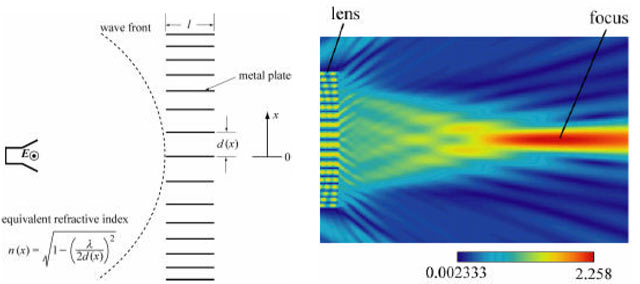| 電磁波伝送システムの諸特性を2次元または3次元波動方程式の境界値問題として高精度かつ高効率で解析し、所望の特性をもつ回路素子や伝搬空間を能率よく設計するための手法を開発している。これまでに、対象に応じてモーメント法、モード整合法、等価波源法、点整合法などの適用範囲を拡大してきた。 |
| 回折格子を利用したマイクロ波・ミリ波や光の偏波弁別・波長弁別・吸収素子・集束素子(Figure 1の金属板レンズはその一例)、フォトニック結晶、導波管フィルタ、マイクロストリップ線路などを扱っている。最近は、粗い導体表面における高周波電力損、電波吸収体の広帯域化、マイクロ波回路用の伝送路や素子の設計公式の構築、高速ディジタル回路の伝送波形の高品質化などにも注目している。 |
Development of the techniques on Computational Electromagntics : Characteristics of electromagnetic wave transmission
systems are analyzed accurately and efficiently as boundary value problems of wave equations. Range of application is
extended concerning the moment method, mode matching method, equivalent source method, and point matching method.
Applications to Microwave Circuits and Electromagnetic Compatibility : Treated objects are diffraction gratings,photonic crystals, waveguide filters,microstrip lines. Figure 1 is one of the examples using parallel metallic plates that works as a microwave lens. Recently,attentions is paid for AC loss on rough metal surface, wideband electromagnetic absorbers, construction of design formula for transmission lines and devices,improvement of the waveform of highspeeddigital circuit.

Figure1 Metal plate lens
|